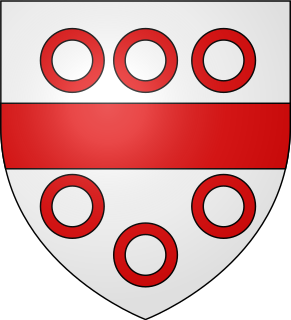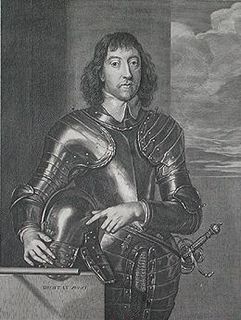The peerages in the United Kingdom are a legal system comprising both hereditary and lifetime titles, composed of various noble ranks, and forming a constituent part of the British honours system. The term peerage can be used both collectively to refer to the entire body of nobles, and individually to refer to a specific title. British peerage title holders are termed peers of the Realm. The peerage's fundamental roles are ones of government, peers being eligible to a seat in the House of Lords, and of meritocracy, the receiving of any peerage being the highest of British honours. In the UK, five peerages or peerage divisions co-exist, namely:

Duke of Norfolk is a title in the peerage of England. The seat of the Duke of Norfolk is Arundel Castle in Sussex, although the title refers to the county of Norfolk. The current duke is Edward Fitzalan-Howard, 18th Duke of Norfolk. The dukes have historically been Roman Catholic, a state of affairs known as recusancy in England.
A courtesy title is a form of address in systems of nobility used for children, former wives and other close relatives of a peer, as well as certain officials such as some judges and members of the Scottish gentry. These styles are used "by courtesy" in the sense that persons referred to by these titles do not themselves hold substantive titles. There are several different kinds of courtesy titles in the British peerage system.

Marquess of Winchester is a title in the Peerage of England that was created in 1551 for the prominent statesman William Paulet, 1st Earl of Wiltshire. It is the oldest of six surviving English marquessates; therefore its holder is considered the premier marquess of England. The current holder is Nigel Paulet, 18th Marquess of Winchester, whose son uses the courtesy title Earl of Wiltshire.

Marquess of Huntly is a title in the Peerage of Scotland created on 17 April 1599 for George Gordon, 6th Earl of Huntly. It is the oldest existing marquessate in Scotland, and the second-oldest in the British Isles, only the English marquessate of Winchester being older. The Marquess holds the following subsidiary titles: Lord Gordon of Strathaven and Glenlivet and Earl of Aboyne, and Baron Meldrum, of Morven in the County of Aberdeen
The Peerage of the United Kingdom is one the five Peerages in the United Kingdom. It comprises most peerages created in the United Kingdom of Great Britain and Ireland after the Acts of Union in 1801, when it replaced the Peerage of Great Britain. New peers continued to be created in the Peerage of Ireland until 1898.

Baron Mowbray is a title in the Peerage of England. It was created by writ for Roger de Mowbray in 1283. The title was united with the Barony of Segrave in 1368, when John Mowbray, 1st Earl of Nottingham and 5th Baron Mowbray succeeded to that title, and in the next generation the Baron Mowbray was named Duke of Norfolk. With the childless death of Anne Mowbray, 8th Countess of Norfolk in c.1481, the Barony went into abeyance between the Howard and Berkeley families, and both styled themselves Baron Mowbray and Seagrave.

Marquess Townshend is a title in the Peerage of Great Britain held by the Townshend family of Raynham Hall in Norfolk. The title was created in 1787 for George Townshend, 4th Viscount Townshend.

Marquess of Cholmondeley is a title in the Peerage of the United Kingdom. It was created in 1815 for George Cholmondeley, 4th Earl of Cholmondeley.

Baron Lucas is a title that has been created twice in the Peerage of England. The second creation is extant and is currently held with the title Lord Dingwall in the Peerage of Scotland.

Baron Strange is a title which has been created four times in the Peerage of England. Two creations, one in 1295 and another in 1326, had only one holder each, upon whose deaths they became extinct. Two of the creations, that of 1299 and that of 1628, are extant. The surname Le Strange was Latinized as Extraneus. The arms of Le Strange of Knockin Castle in Shropshire were: Gules, two lions passant argent.
The hereditary peers form part of the peerage in the United Kingdom. As of September 2022, there are 808 hereditary peers: 29 dukes, 34 marquesses, 191 earls, 111 viscounts, and 443 barons.

Edward Howard, 9th Duke of Norfolk, of Worksop Manor in Nottinghamshire and of Norfolk House in London, was a British peer, politician and hereditary Earl Marshal.
The title Baron Maltravers or Mautravers was created in the Peerage of England on 25 January and 23 October 1330 when John Maltravers was summoned to Parliament by writs directed Iohanni Mautravers Iuniori. The barony fell into abeyance among his granddaughters and coheirs, Joan and Eleanor, at his death on 16 February 1364. At the death of Joan without issue, Eleanor became, according to modern doctrine, de jure Baroness Maltravers. The barony later became a subsidiary title of the Earl of Arundel and subsequently the Duke of Norfolk.
Baron Arundel was a title in the Peerage of England created on 4 August 1377 by the summons of John Fitzalan to Parliament as "Johanni de Arundell". As he was then married to Eleanor Maltravers, coheir and eventual sole heir of John Maltravers, 1st Baron Maltravers, this is sometimes taken to be identical with the Barony of Maltravers. The barony subsequently came to be held by the Earl of Arundel, now itself a subsidiary title of the Duke of Norfolk.
A writ in acceleration, commonly called a writ of acceleration, is a type of writ of summons that enabled the eldest son and heir apparent of a peer with more than one peerage to attend the British or Irish House of Lords, using one of his father's subsidiary titles, during his father's lifetime. This procedure could be used to bring younger men into the Lords and increase the number of capable members in a house that drew on a very small pool of talent.

Henry Frederick Howard, 15th Earl of Arundel PC, styled Lord Maltravers until 1640, and Baron Mowbray from 1640 until 1652, was an English nobleman, chiefly remembered for his role in the development of the rule against perpetuities.
Several baronies created by error exist or have existed in the Peerage of England and the Peerage of Ireland. The usual type of error was perpetrated in the Committee on Privileges of the British House of Lords, whether by the Committee itself or by a clerk, in mistaking the origins of a dormant, abeyant, or extinct title, and in awarding that title to a person who was not the heir to that peerage. Such mistakes are rare.

In England, the baronage was the collectively inclusive term denoting all members of the feudal nobility, as observed by the constitutional authority Edward Coke. It was replaced eventually by the term peerage.








